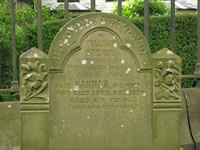(…)
Blacheburn: King Edward held Blackburn. 2 hides and 2 carucates of land.
The Church held 2 bovines of this land and St Mary's Church had 2 carucates of land in Whalley exempt from all customary dues.
In the same manor woodland 1 league long and as wide as a hawk's syria.
To this manor or Hundred were attached 28 free men who held 5 and a half hides and 40 carucates of land as 28 manors.
Woodland 6 leagues long and 4 leagues wide.
They were (subject to) the aforesaid customs.
(…)
Roger was born c 1058 the third son of Roger of Montgomery II who supported William I in the conquest of England. Roger de Poitou was said to have received the land in gratitude for his father's service during the Norman Conquest. He was made first Duke of Lancaster.
I often wonder what Roger de Poitou felt when he received this unpromising parcel of land far away from anywhere sensible at that time. Was he grateful or did he feel his family's work was under-appreciated? Was he jealous of others who received 'better' (i.e. more income-generating) land elsewhere? Did he even know (or care) Blacheburn existed?
Anyway he didn't hold it long as Domesday continues….
Roger of Poitou gave all this land to Roger of Bully and Albert Grelley. There are as many men as have 11 and a half ploughs, to whom they granted exemption from dues for 3 years. It is therefore not now assessed."
But by 1092 he had gained it back, and by 1102 Henry I granted it to tStephen of Blois after Roger was involved in a failed rebellion against the king. He returned to France and died sometime between 1122 and 1140.
(I have no primary sources for Roger de Poitou and readily available secondary sources, print and online, are contradictory.)
When de Poitou fell fro grace his lands were awarded to the de Lacy family. Published dates (in secondary sources) for this vary between 1102 and 1121, in the Baronecy of Ilbert’s son Robert (d ~ 1130), the second Baron. Clitheroe Castle was substantially built during this period.
The third Baron, Ilbert (d ~ 1141) was captured with King Stephen at the Battle of Lincoln. After his death his brother Henry (d 1177)became 4th Baron, followed by Henry’s son Robert (d 1193), the 5th Baron.
Following the death of Robert de Lacy, (5th Baron) who died childless, the Baronecy passed through:
Albreda de Lacy (m Robert de Lissours) the daughter of Robert de Lacy (2nd Baron)
her daughter, Albreda de Lissours (m Richard FitzEustace)
John FitzRichard (d 1190). John founded Stanlow Abbey in 1178.
to Roger FitzJohn (1170-1211) on the condition he changed his name to de Lacy. Roger enlarged the estate, acquiring Rochdale amongst other places.
Roger de Lacy was said to be a colourful character. There is speculation that in his earlier days he was the Sheriff of Nottingham of ‘Robin Hood’ fame. Later he is said to have defeated the Welsh rebellion in 1210 with a collect of singers, musicians and beggars. However despite the relatively non-violent defeat of the rebellion his subsequent treatment of the rebels was ferocious.
Next in line were:
John (c 1192-1240), who is named on Magna Carta. He also acquired the fee of Tottington.
Edmund, (c 1230-1258)
Henry (c1251-1211). Henry apparently oversaw the movement of the monastery from Stanlow to Whalley in 1296. This probably included the transfer of the bones of Roger and John de Lacy to Whalley.
Alice de Lacy who married Thomas Earl of Lancaster. Most of her estate, including he lands in Lancashire, transferred to him as part of her marriage settlement in 1311.
Although they may rarely if ever visited the area their influence was profound:
- Rossendale was at this time a private hunting chase for the de Lacy family and as such subject to forest law and relatively unsettled.
- The Abbey at Whalley became the parish church for Rossendale, including the Springhill area. This necessitated a journey of 12 miles across open moor for baptisms, weddings and funerals.
- The marriage of Alice de Lacy and Thomas of Lancaster led to the land being transferred into the Duchy of Lancaster
He, together with the other tenants of Deadwenclough, was elected Greave of Rossyndale in 1516. Why the office of Greave was allocated to a group rather than an individual and how this worked in practice is not recorded. Sadly.
In 1527 there was an entry in the Halmote records of the manor describing how Jordan, by ‘Synister labor, Craft and subtilite’ ‘fined and connveyed’ to deprive Adam his brother of his share of the lands on deforestation ‘value of xxs’ in Deadwenclough. The ‘false and untrue delying’ was ‘openly Kawne’. As a consequence of mediation by their friends the matter went to court which found for Adam. Jordan was ordered tom compensate Adam which Jordan refused to do ‘contrariety to all gud Right and conciens and his faith and fidelity and contrary to his seyd agreement thereof ‘ and the Halmote ‘pray…for…Reformacien’.
(Farrer vol III pp 58-9).
Then next year (1528) he was sued together with his brother Adam and other tenants of Deadwenchough for trespass with beasts, a common offence in the area. The common pasture was largely in the west of Rossendale and the modern rights of way numerous and complex, reflecting the various routes taken by farmers in moving their animals.
In 1534 he was fined 4d (together with 7 others) for making a ‘marle pyt’ Marl Pits field later became part of Springhill Farm and is now a sports complex. It has notoriously bad drainage, not surprising given its name.
In Jan 1536/7 Jordan, together with three others, sued 4 neighbours over partition of land in Deadwenclough called ‘The Edge’, just above Springhill. Four others were ordered to divide the land equally amongst all the parties.
1541 finds Jordan together with Adam and John Bridge being sued for obstructing a right of way and was bound over for 6s 8d to repair it before the feast of St John the Baptist. The vicar was charged with deciding which man had to clear which bit.
Jordan Bridge died in 1546. His son John was admitted tenant (fine 16s 3d, probably one year’s rent). Christopher and Frauncis Bridge forbade fine by right of inheritance. This was to granted, but John Bridge surrendered the land to Christopher shortly afterwards.
It appears that Jordan may not have been above a bit of dubious dealing. It also gives a flavour of how hard life was in the early part of C16, with people trying to exist in pretty unpromising terrain and the squabbles which emerged as the land was deforested (in 1507) and began to be inhabited.
Monck's part in the restoration of Charles II was rewarded in a number of ways, one of which was his being granted the Honor of Clitheroe in 1661. As this includes Springhill (then known as Deadwenclough), Monck became the lord and landowner.
It didn't take him long to realise that the officers of the Honor had been somewhat tawdry in the paying of rent and other dues and in 1662 he established a survey couched in beautiful C17 language which pulled no punches:
'Whereas as by the greate negligence of the Steward and Under Steward that have heretofore kept the severill Courts of the Mannors within the Honour of Clitherow many and great disorders hath beene committed by reason that they seldome or never kept any Courts of Survey but minding their own profit more than his majesties advantage they tooke noe care to perfect the Rentalls between his majestie and his tenants…'
At some stage Richard took possession of Chapel Hill Farm. By 1663 he had released land for the Friends' burial ground and allowed meetings for worship in his farm. Quakerism is said to have been introduced to Rossendale in 1653 by William Dewsbury and Thomas Stubbs; if so they must have been pretty early converts as they were fined for attending Quaker meetings and tithe refusal in 1660/1 and again in 1665 and again in 1668…
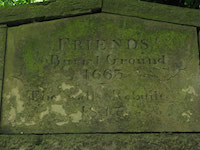
His daughter Isabella is said to have married Abraham Haworth, who in 1691 petitioned for a licence for protestant dissenting worship in his house. The request does not specify Quaker worship.
Richard Radcliffe died in 1675 and is buried in the Friends' Burial Ground, Chapel Hill.
Sources:
baptism Whalley OPC Register Baptisms 1605-1632 p 11.
Ratcliff CE, (1963) 'Richard Radcliff of Lancashire, England and Talbot Co, Maryland, his ancestors and descendants'. It appears to be 'our' Richard's son, also Richard, who emigrated. There are a number of basic errors in this source and it should be treated with caution.
'Nightingale, Early Stages of the Quaker movement in Lancashire' London Congregational Union 1921.
Burial Register, Friends Burial Ground
It was probably, but not absolutely certainly, the barn at Lodge Fold Farm which stood in the centre of Higher Cloughfold on the southern boundary of Springhill. Lodge Fold Farm was built in 1629 and rebuilt in 1854.
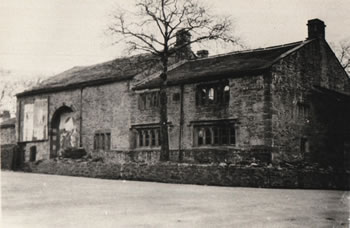
It stood until 1936 when it was sadly demolished for road widening, being replaced by a grassed area, a bus stop and a set of public toilets. Given the speeds at which cars traverse the village, many wished it had been retained for traffic calming…

The 1629 datestone was removed when the farm was demolished and set in a 'history wall' in the grounds of Whitaker Museum in Rawtenstall, from which it was removed one night with the 'assistance' of a JCB. It was the only stone taken.
So much for the barn, what of the man?
John Piccop of Deadwenclough received wages in 1672 'for the graveship of the Forest of Rossendale' from John Ormerod
(LRO NCHa/71/2. Quite why they are filed with the records of the National Coal Board I'm not sure…it is under 'Miscellaneous'…) This is not on the list of Greaves in Newbigging's 'History of the Forest of Rossendale'.
John s James Piccop was baptised May 1630 Newchurch St Nicholas (LDS Film 1040340) This John would be age 42 in 1672 so plausible, indeed he is the only plausible candidate baptised at Newchurch. However there is no guarantee he was baptised there or, given his later nonconformist sympathies, baptised at all.
Putative marriages, all St Nicholas:
Elizabeth Mills 22 Nov 1663 (bur 30 Jan 1668/9)
Dorothy Hamar 8 Jul 1669 (bur 9 Jul 1680)
Alice Whittaker 19 April 1676 (poss bur 6 Oct 1688 abode 'Wainyate', or 11 June 1680)
Jana Heyworth 5 Nov 1671
Alice of Wainyate is an interesting candidate given his interests in the area.
Johannes Piccop bur 20 Jun 1691 St Nicholas, abode Dewinclough. Sion was still meeting in private property and didn't have a graveyard at that time. He is not listed in the register of interments for the Rossendale Quaker burial grounds. Again, these are speculative.
So actual facts are scanty. However, if he was the Greave in 1672, we may have his signature…
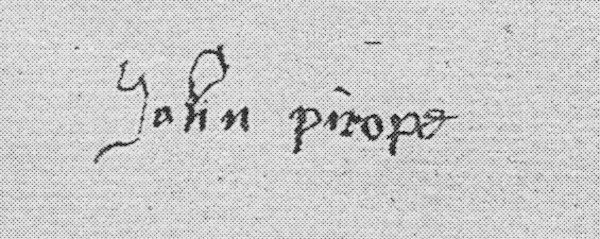
He was Greave of Rossendale in 1600.
His son John was baptised 28 Sept 1640. His will refers to son Richard and daughter Dorothy Pilling but their baptisms are not in the Lancs OPC transcript of Newchurch church.
He was buried on 21 Dec 1654. His will of that year commits his soul to ‘the hands of Almighty God my Maker and Redeemer by the Meritts of whose death and passion by mercy through faith I trust to be saved’ and his body to be buried in Newchurch in Rossendale.
Half his monetary estate was to be divided between son Richard and daughter Dorothy. The other half was split between 12 friends and acquaintances in small amounts.
A fourth part of his land was to his elder son William ‘which went out of England long since if hee be lyvinge and Returned agayne into England’ within 3 years of his decease.
There was a further bequest to ‘John Heaton alis Bridge Twenty shillings in a yeare for the tyme of four yeares after my death And fourty shillings to bind him Prentice to learn some trade if any man will undertake to doe it for him’.
Sources:
1609 tenancy:
Grimshaw MS. and Duchy of Lanc. Special Com. 722, cited in 'Townships: Newchurch', in Farrer W and Brownbill J (ed’) A History of the County of Lancaster: Volume 6’, (London, 1911), pp. 437-441 (access to the early documents is limited and the LRO encourage the use of transcripts)
Greave:
Newbigging, History of the Forest of Rossendale 1st end pp 97-107.
Baptism
LDS film 1040340 via the Lancashire OPC.
Burial
Lancashire OPC from parish records
QSP 198/9
Quarter Sessions Preston Michaelmas 1660
maintenance of child of Francis Bridge
Francis had married Ann Chadwick of Spotland (Rochdale parish, but the township extended to about a mile away). The couple had a son at some ungiven date and a daughter reasonably close to 1660. Francis abandoned Ann virtually at confinement, leaving her to be supported by friends. The matter was brought to the Quarter Sessions by the churchwardens who did not want responsibility for the upkeep of the child to fall to the parish, particularly as Francis had recently come into an inheritance. Interestingly one of the wardens is one Adam Bridge, almost certainly a brother/uncle/father/…
QSP 202/24
Quarter Sessions Preston Epiphany 1660/1
Maintenance of Anne daughter of Francis Bridge of Deardenclough yeoman
Francis Bridge (or probably more than one) was engaged in a number of land surrenders between 1666 and 1691. Unfortunately the court rolls for this period haven’t been transcribed.
The parish records for Newchurch St Nicholas include the baptism of a son of Francis Bridge in 1565 but not of a daughter, Anne or otherwise, around 1660 nor of the death of a child of Francis around that date. They do record the death of an unnamed wife of Francis Bridge on 9 Jan 1659/60 - how did they not know her name, or why did they not record it?
Newchurch St Nicholas appointed a new rector in Dec 1662. This need not imply the ejection of the previous incumbent under the Act of Uniformity
The Lancashire OPC transcripts for St Nicholas record Johannis Kippax, Curate, as conducting marriages and baptisms in 1661. He conducted a baptism there on 10 May 1663 and so was officiating on both sides of the Act of Uniformity.
According to ’The Clergy Database’ he was ordained 21/12/1662 by the Archbishop of York, which is interesting if he was officiating in Newchurch before then. He was licences to preach in Haslingden St James on 3/8/1662 and in Church (probably St James at Church, Accrington) on 14/7/1668. In 1674 he is listed under ‘Churchekirk et Haslingden’
He is thought to have been incumbent at Haslingden when he died in 1679.
It is unlikely therefore that he had issues with conformity. He may have undergone a temporary suspension in 1662 due to lack of episcopical ordination.
So however romantic the story and however much the historians of Sion wanted their church to date from the Act of Uniformity, the Kippax story appears to be untrue.
Sources:
Ordination 21/12/1662 by Archbishop of York (CRO EDV 2/9 1677)
Licenced 3/8/1665 Preacher Haslingdon. by George/Chester CRO, EDV 2/8 1674 Licensed to preach in :Capella de Hasleingden et alibi’. Subscribed the same day.
Licensed Curage 14/7/1668 by George/Chester as Curate and Preacher of Church alias Church Kirk Subscribed the same day CRO EDV 2/8 1674
26/7/1674 listed under ‘Churchkirke et Haslingden’
(Churchkirk usually refers to St James, Church, Accrington, though St Nicholas has been known locally as ‘Kirk Church’)
1677 visitation listed at Haslingden, also at Church
Calamy, Edmund The nonconformist’s memorial: being an account of the lives, sufferings, and printed works of the two thousand ministers ejected from the Church of England, chiefly by the act of uniformity Aug 24 1666 vol 2. 1802
Listed in ‘History, directory and gazetteer of the county palatine of Lancaster’ by Edward Baines and William Parson as having resigned/ been evicted under the Act of Uniformity from Newchurch in 1662
In 1686 the churchwardens of Newchurch St Nicholas certified to the Quarter Sessions that James Pilling:
- 'had played the thief'
- 'kept his cattle and horses upon other mens pasture, having none of his own'
- 'keeping in a house contrary to the will of its owner'
- 'an idle dissolute persen'
- 'a grabbing quarrelsome fellow'
- 'much disquiete troubles and wronging his neighbours'
- 'in a word he is a lawless person and cares not so what he doth speakes or swears'
mmm, maybe he was worse than most after all.
Interestingly he is identified in this document as being a woollen weaver, at a time when most people existed by a combination of smallhold pastoral farming and outsourced weaving.
QSP 622/28
It is said that Mitchell was imprisoned twice under the Conventicle Act in the 1680s. One of these is said to have been after preaching at Goodshaw, north of Rawtenstall. I have not been able to verify that.
Crossley extended his circuit to include areas of the Midlands and South of England and eventually ended up in Cripplegate. Sadly his time there may have not been entirely straightforward, with rumours of excessive drinking and some indiscretion towards women.
Many of the preaching stations used by Mitchell and Crossley developed into nonconformist churches in their own right. Sion was one of these so Mitchell can be described at its co-founder. He was also the first pastor of Sion chapel, Cloughfold, serving from 1685 to 1699 when he was dismissed (probably over the issue of believer's baptism) and succeeded by Richard Ashworth. Mitchell became minister of Rawdon Church, Yorkshire.
He died in 1705 aged 42.
'Yet the principles for which [Mitchell] stood were gradually winning their way with the Cloughfold Church for, in the document transferring the house property from James Townend to the Church (in 1701) the community is described as Anabaptist'
(JS Hardman, Sion Baptist Church 300th Anniversary Handbook)
Crossley returned as Baptist minister in Bacup in 1702.
Litchford stipulated in the deeds that the ‘same shall be made fit and commodious for a chapel or meeting place’. This building was used for worship until 1839 when a stone chapel was built. It is widely reported that the church was built on the site of Litchford’s property.
In the surrender entry Litchford is described as being ‘of Blakely in the County of Lancaster, Gentleman’. It appears that he was originally from Manchester, buying land in Blakley in 1676.
Robert Litchford was buried on 19 Jan 1710 in Blakley. In his will (28 Jan 1710) he left £150 upon trust to the Trustees of Sion. Apart from 40s/annum for the support of the poor, the income of this was to be used to support the ‘minister, pastor or teacher of the said congregation provided they never be at one time a month without preaching’. His will also detailed considerable tracts of land in various parts of the country which were left to his nephew.
In the same will, a Mr Thomas Jackson inherited his best cow.
He may have been married twice, with Ellen wife of Mr Robert Litchford bur Blakley 17 Jan 1701 and Mary wife of Mr Robert Litchford bur Blakley 11 Mar 1710.
In 1986 the chapel was demolished and the stone used to provide sheltered housing on the same site. This is administered by the Baptist Housing Association and the new building known as Litchford House.
Quite how Litchford became interested in dissenting congregations in general and Cloughfold in particular are not known.
Sources
(All secondary, I’m afraid)
Snell Alan P (2013). The Theological Education of the Ministry ch 2 pp 5-56
British History Online for the Blakeley details
JS Hardman’s Baptist History articles
extract, indenture 1676
extract, will Robert Litchford 1710
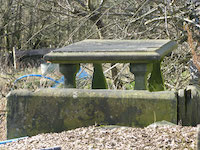
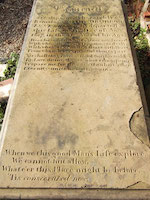
Beneath Are deposited the earthly Remains of JAMES ORMEROD INNKEEPER who departed This Life the 9th Day of NovR 1817, in the 57th Year of his Age Dear, loving faithful Partner now farewell With whom it was my Happiness to dwell With whom I was united Heart with Heart From whom it is so painful thus to part Yet shall the gracious Hand that thee took hence By Love divine thy Absence recompense Prepare me for the bliss thou hast & then Eternity unite us both again When we this good Man’s Life explore We cannot but allow, Whate’er this Place might be before ‘Tis consecrated now.
Local legend has it that his burial at this site was due to suicide debarring him from the local parish churchyard. Possible, but I have been unable to verify this.
A coal merchant he definitely was however, being one of the major partners of Ashworth Hargreaves & Co, the major pit owners in Rossendale with at least 17 collieries in Rossendale and a further four in Baxenden. These were small scale pits working seams in pats no more that 18” thick and in the main supplying local mills for steam production. This is an example of how developments in one field, in this case the mechanisation of the textile industry and the steam engine, led to business opportunities in related areas. The coal had to be moved somehow and Ashworth was a shareholder in the local turnpike companies. This didn’t stop his coal company creating two access roads from one pit (Old Meadow in Bacup) to the main road so customers from both directions could avoid the toll bar. No wonder the turnpikes never made money.
Having money didn’t prevent the family from tragedy, with one child dying in 1810 age 1 and another in 1844 aged 35.
John Ashworth died in 1850. His will described how he was charged under the will of his father Richard to pay an annuity to his sister Ann during her spinsterhood and John in his will left instructions that this should continue after his death. His land and shares were left to his spinster daughter Mary Ann, of whom more below.
He remained connected with St Nicholas all his life and left his pew there to his daughter Mary Ann. I’d love to know which one it was…
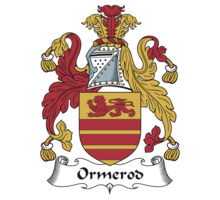
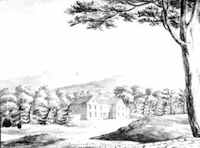
Ormerod House c 1811
The settlement prior to Charlotte Anne’s marriage in 1835 also describes the surrender into Trust of ‘Clough Fold farm’ but this is not otherwise described. This surrender also describes the surrender of ‘tenements in Habergham Eaves and the Colliery’. Whilst it helpfully doesn’t specify which colliery, Habergham Eaves (where they may have been a colliery) and Gambleside (where there definitely was a colliery) are very close to Ormerod. Now Gambleside was owned by Ashworth Hargreaves Co - the Ashworth being the one who bought the land from Charlotte Anne. John Ashworth’s wife was Betty Ormerod and there are hints in his obituary that he was linked with the Ormerod family from Whitewell Bottom, almost certainly an offshoot of the Burnley Ormerods. It is tempting to speculate that there was a familial link between John Ashworth and Charlotte Anne Hargreaves via her mother, this remains unproven (or, indeed, un-searched for!).
Charlotte Anne Hargreaves married James Yorke Scarlett in 1835. As he came from Middlesex, I wonder how they met - he was billeted at Burnley Barracks but that seems unlikely. There was no issue.
Scarlett rose to Lt-General and was commander of the charge of the heavy brigade at the battle of Balaclava. He was MP for Guildford (Cons) from 1837-1841 without any apparent connection with the town and stood unsuccessfully for Burnley in 1868. He is recorded in the Country Families of the United Kingdom1860, pg 886-887.
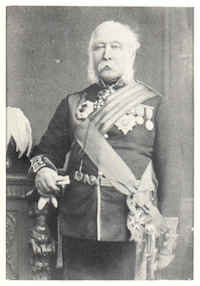
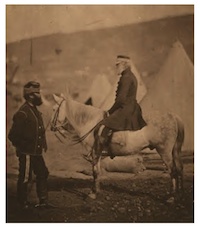
Charlotte Anne Scarlett nee Hargreaves died 9 Feb 1888 leaving (after two revisions) £627,738 15s 6d (Probate Calendar).
On the 1851 census she is residing with her younger sister, Sarah, in Newchurch
Mannex 1854 states Rebecca Davenport, milliner, Newchurch
She was obviously a lady of some substance, owning stocks in the Liverpool Consolidated Gaslight Company, Shares in the Manchester and Liverpool District Banking Company and rental income from property on Coverdale St, Hamlet St, Emma St and Railway View in Ardwick, Manchester.
She died on 4 Sept 1893 and her will is fascinating.
She starts with the usual naming of executors with a legacy to each and a legacy to her nieces and nephews from the proceedings of her investments. Then follows a legacy to the children of her niece or nephews if any should happen to be blind, for as long as they remain blind. If none should be blind then the money is to go to blind people associated with the Chapels and Churches of Cloughfold, Mill End, Newchurch and Waterfoot and the congregational Chapel at Newchurch. There obviously were no blind family members as Bathsheba’s trust was mentioned in the Lancashire VCH entry for Newchurch in the above terms. The charity was registered with the charities commission in 1966 and removed in 2007 with income of £50. I don’t know if they ever paid out.
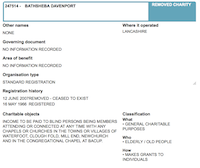
In addition there were a number of personal bequests in a codicil, many amended during drafting, including pictures of Mr and Mrs Gladstone with frames to one great nephew (gee, thanks) and her underclothing in equal shares to her two nieces (ditto - one take the bras and the other the knickers?) plus £5 to a couple of nonconformist ministers, one of whose names she did not know.
The blind bit got me thinking - reversible causes of blindness in the 19th century? There are a number of medical conditions of which blindness is a symptom which reverses at the condition improves but many of these were not treatable in C19. Many of today’s causes are preventable or treatment stops progression rather than truly reversible. So that leave us with cataracts, corneal scarring and retinal detachment to some extent.
Cataract surgery was first performed in 1746 and Freud and Koller’s later work on local anaesthesia was in part to facilitate this - Freud became a psychoanalyst and Koller a cocaine addict. corneal transplant was first attempted in 1838 although not successful before 1905. Retinal detachment surgery was rare before 1900 and rarely successful before the 1920s.
It appears therefore that Bathsheba’s stipulations came at a time when correction of blindness was, in some cases, beginning to become a reality. Did a spinster milliner in Newchurch have any idea of this?
Her obituary stated that she was educated in Rochdale, about 8 miles over the moor. Presumably she boarded, either at the school or with friends. The Ashworths were close friends of the Royds family, major players in Rochdale, so perhaps she stayed there. I have been unable to trace the school but there was a school for the children of gentlemen in Rochdale so it could have been that.
She inherited most of her father’s estate including the lands around Springhill and the interests in the collieries and turnpikes. Census data and her marriage certificate suggest that she never actually did a day’s work.
She married Charles Patrick in 1855 at the age of 46, the ceremony being followed by their funding supper for their tenants at the Red Lion. There was no issue. Their marriage certificate is here. She had all her properties written into Trust before her marriage, a copy of which is included in the deeds…
Patrick rapidly set about developing the estate, enlarging the house, developing the farm and employing a coachman, gardener and groom. Strangely, Mary Ann saw no need for these as a single lady.
Mary Ann Patrick inherited land in Edgeside from her mother. In 1872 she donated land for the development of a school in Edgeside. This opened in 1873 and was licensed for worship in 1876. Mary Ann laid the foundation stone ‘with full masonic ceremonial’. She also identified land for a church and parsonage and willed money for their construction. The church was consecrated in 1885, still unfinished, leading a somewhat grumpy Bishop to amend his sermon accordingly.
Mary Ann Patrick nee Ashworth died in 1883 aged 74. She is commemorated in St Anne’s church, Edgeside, by a stained glass and less obviously by half the roads in the area being named Ashworth Lane, Ashworth Road etc. She and her sister also erected a memorial to their father in St Nicholas’ Newchurch.
Her will is complex and poorly drafted resulting in a land dispute between her nieces which had not been settled 15 years later.
On 31 Dec 1837 she married Richard Nuttall in St Nicholas. She was a minor at the time of her wedding, a useful fact in trying to demonstrate just which of the 'Alice, daughter of John Ashworth’ she was.
Richard and Alice had four children:
Henry b 1838
Jane b 1842 - my ancestor. Her first husband, John Taylor (my ggf), was rather gruesomely killed in a quarry accident.
Alice b 1845
Richard b 1851.
Alice lived in 3 Edge Lane for over 30 years, being recorded there in the 1861-1891 censuses. She was widowed by this time and worked as a laundress, probably taking in washing from Captain Patrick of Springhill House and others of the rich and famous of the district.
Alice's example is remarkable not for the details of her life which are quite straightforward but as an indicator of the social structure of the neighbourhood and how that changed over time. Her two-roomed cottage was within 20 yards of the big house which dominated Springhill. Of the 10 houses in Springhill at the time, 5 had 5 rooms or more, 3 had only two.
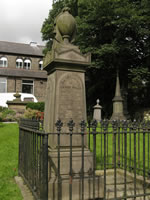
From the information on the stones we can construct a reasonable tree of the family:
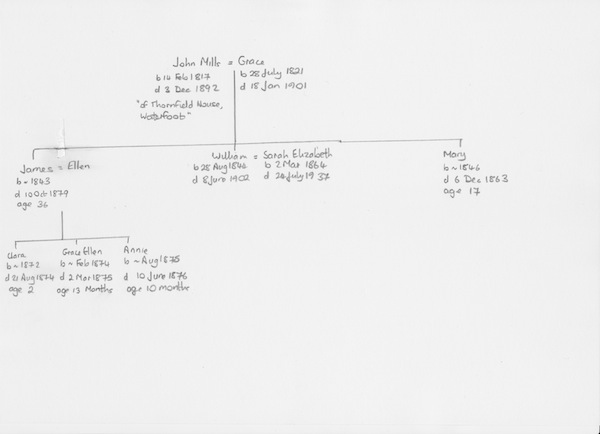
From this we can see a few things of interest:
William was 20 years older than his wife Sarah
James and Ellen lost 3 daughters before they were 3.
Grace Ellen died and Sarah Elizabeth were born on March 2nd (although different years)
John had lost both a son (James) and a daughter (Mary) before he died.
The census dataset adds relatively little to this. He was indeed of Thornfield House, Waterfoot for at least 10 years before he died, and was in the Waterfoot areas for well over 20 years. During this time he worked as a blacksmith then clog iron manufacturer - a relatively limited field but many people wore clogs then.
Thornfield House isn't marked as such on the 1890 OS map but may have been the one on the left (north side) half way up Thornfield Road.
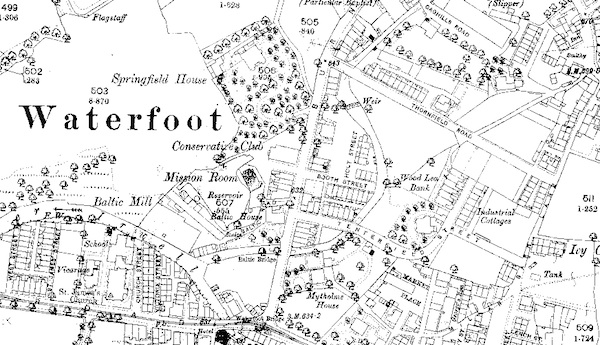
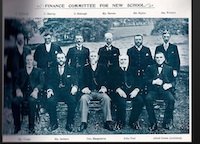
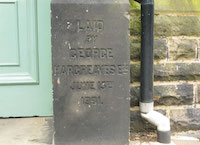
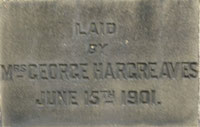
George was born c 1834 in Crawshawbooth, woollen waste dealer.
m 1 Elizabeth (Betty) Ashworth q3 1856 and had two children:
Betty b ~ 1857
Jane Ellen b ~ 1860
m 2 Mary Ann Ormerod q4 1899. Mary Ann b 1844 the daughter of John and Maria Ormerod, woollen manufacturer turned grocer by 1861. Interestingly Mary Ann is shown in 1881 at 71 Newchurch Road as a general servant and 1891 at the same address as living off her own means.
George lived at Lord St, Newchurch in 1861, cotton dresser. By 1871 he was at 1 Green Bank Cottages and 1881 occupation waste dealer. On remarriage he moved with his new wife into her previous home, 71 Newchurch Road.
By 1871 he was a married man, having married Betsy Taylor q1 1869 in Haslingden district. Betsy was born ~1842 in Musbury and gave her occupation in 1871 as a milliner. Lambert and Betsy lived in Bidleway Bottom, Newchurch.
In 1881 both Lambert and Betsy were recorded as drapers, still in Bridleway.
1891 has Lambert still in drapery but also ‘mineral water manufacturer’, a strange combination. Although their address was recorded as 116-118 Burnley Road, the adjacent properties make it clear that it was actually Burnley Road East. There were a number of mineral water manufacturers in the area at that time, including one run by my gg uncle John William Taylor. Perhaps it was the same one?
In 1885 he founded his slipper manufacturer company, Lambert Howarth & Sons, trading as Osbornia footwear. He had two mills, Greenbridge Mill in Fallbarn, Rawtenstall and another in Healy Royds, Burnley.
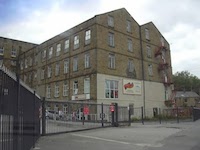
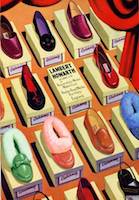
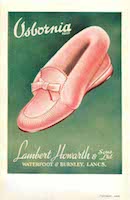
Lambert and Betsy had three children:
William Robert Howarth b ~1871 Newchurch
Charles Frederick Howarth b ~ 1873 Newchurch
Ernest Taylor Howarth, b ~ 1881 Newchurch
(Lambert helpfully listed them all on the 1911 census even though none were resident with him at the time and one had been dead for 20 years!)
Sadly their prosperity didn’t protect them from tragedy and Ernest died q4 1881 aged 7 months. He is buried in Sion graveyard, in a grave containing the remains of a number of infants from different families.
Lambert Howarth died in 1918 and is buried in Sion Baptist graveyard.
This documentary about Lamberts gives an idea of the troubles faced by the Lancashire footwear industry in the 1990s. Lambert Howarths went into administration in July 2007 after losing a contract with M&S. Greenbridge Mill still stands but was emptied following a flood in 2016. Greenbridge Mill previously housed the Footwear Museum and the current location of the contents is unknown.
The museum also contains the stone cross from Bethel Baptist Church, Waterfoot, now demolished. The accompanying plaque explains that this was purchased by John Howarth when Bethel was demolished in 1996 and installed at Lamberts. It explains that Bethel was built with funds from Sir HW Trickett, a major slipper manufacturer in Waterfoot and so the acquisition of the cross was ‘in keeping’ with the museum and Trickett’s contribution to the Rossendale slipper trade.
The only problem is that Bethel was built in 1868 and Trickett was born in 1857…however he was baptised there in 1877 and served as Sunday School superintendent, deacon and treasurer.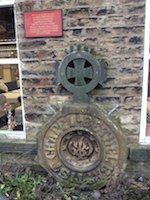
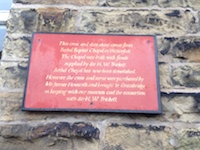
gravestone, Sion Baptist Church
1911 RG14 - PN24702 RD471 SD1 ED8 SN251
1901 RG13/3849
1891 RG12/3347/F
1871 Bridleway bottom
Lambert Howarth Cotton mule spinner b Whalley
Betsy Howarth milliner b Musbury
1861 Lodging Foresters House, Bridleway,
He was born ~1842 in 'Cloughfold' at a time when Cloughfold comprised of only a couple of dozen properties or so. He was the 5th son of George Ormerod, Stone Mason and his wife Betty. He is still there, in 'Cloughfold', in 1851.
It was no better in 1861, when Thomas was living in 'Cloughfold' with his parents. By this time he was working as a labourer. Interestingly this household on census night included three grandchildren of George and Betty, each with different surnames… Schofield, Ingham and Ormerod.
1871 finds him married to Fanny with two children, John Thos (b ~ 1866) and Jane Ann (b ~ 1870). He is now a farm servant in 'Cloughfold'. In 1866 at the baptism of John Thomas (at Newchurch St Nicholas) his occupation is given as 'gardener'.
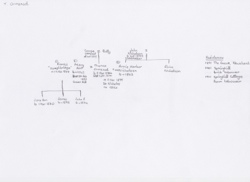
1881 'Thirteen Cloughfold' with wife Mary Ann (b Preston, ~ 1842) and children Jane (b ~ 1870), James (b ~ 1871) and John Richard (b ~ 1873) together with a niece Sarah Jane Lonsdale, b Cloughfold ~ 1855 and male lodger John Taylor. By this time he was a farm labourer.
1891 'The Green, Newchurch' with third wife Annie, all of 1/2 mile away if that. Occupation at this time was 'labourer in general'
1901 and 1911 in Springhill. In 1901 this is specified as Springhill Cottage, now a substantial dwelling. He was a farm labourer on both censuses. It is probable that at least some of his time as a farm lab was spent working on Springhill Farm.
He did nothing remarkable that we know of, getting on with his life. Life was sad at times, with him burying two wives, work hard and finances probably tight.
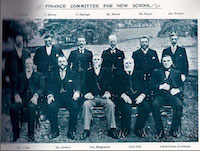
In 2014 this picture was reprinted in the ‘Yesteryear’ section of the local paper with a caption provided by the member of Sion who submitted the picture. He identified Jackson as the last headmaster of Newchurch Grammar School and the first of BRGS (EH Holden, Springhill resident, being the second).
Unfortunately this is incorrect.
The first headmaster of BRGS was called Thomas Ernest, not Henry
TE Jackson was not a Baptist but a staunch Churchman and lay reader at St Nicholas.
So what of Henry?
He is buried in the graveyard as Sion: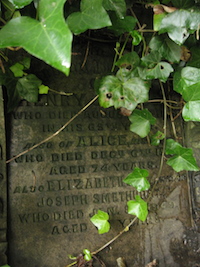
HENRY JACKSON/ WHO DIED AUGUST 1st 1918/IN HIS 65TH YEAR/ALSO OF ALICE HIS WIFE/WHO DIED DECR 6TH 1920/AGED 74 YEARS/ALSO ELIZABETH BELOVED WIFE OF/JOSEPH SMETHURST/WHO DIED JAN 8TH 1949/AGED 66 YEARS.
That has him born ~ 1854 and Alice ~ 1846.
He was born the son of Joseph and Ann Jackson, grocer, of Bacup and latterly Union St, Hareholme. He married Alice Bridge q3 1876 in the Haslingden registration district.
1901 census (RG 13/3850) Henry (b Bacup) was living at 10 Peel St with wife Alice (b Rawtenstall) and children:
Alfred B single age 23 b Rawtenstall
Annie single age 21b Rawtenstall
Lizzie single age 18 b Rawtenstall
Harry King single age 14 b Cloughfold
Harold B single age 7 b Cloughfold
and niece Emily Bridge single age 18 b Bolton
Henry was employed as Cotton Mill Storekeeper
1911 he was still there, by now employed as a Doctor’s clerk.
They reported 8 children of whom 5 were living and 3 had died.
Working backwards, in 1891 (RG 12/3348/F) he was a 8 Peel St with his family and his brother in law Abel Bridge, sister in law, niece and nephew.
1881 he was a cotton warper living in Springside, Rawtenstall. He and Alice lived next door to John and Betty Bridge with children including son Abel.
Elizabeth Jackson married Jospeh Smethurst q3 1905 in Haslingden reg district (8e 0311).
In 1911 William is at 302 Newchurch Road, Marl Pits, about 400 yards west. His daughter Harriet, now Harriet Mannion, is in Springhill Lodge, occupation housekeeper, presumably to RJH Mitchell of Springhill House, of whom more in a later. #52 residents Her husband seems nowhere to be seen… William was born Sheffield, Yorks, Mary Brampton, Lincs (scored out). They made a bit of a mess of the form, listing all their children in the ‘birthplace’ column.
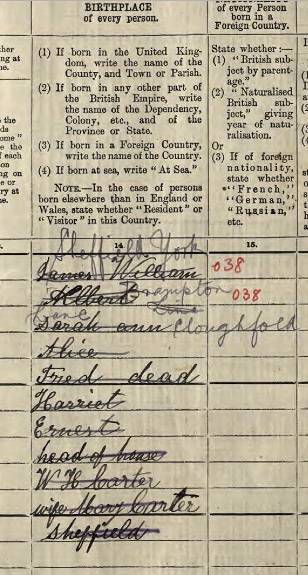
Going back, 1891 finds him in Newchurch about 800 yards away in yet another direction. Here he is born Sheffield, (good), his wife Mary born Brampton, no county given (ok), hitherto unknown son James aged 11 b Sheffield and Albert, 8, born (illeg) Monmouthshire with sibling Sarah A, 8, b Cloughfold.
Monmouthshire?

Well in the timeframe in question (1881 +/- 5 years) there is one Albert Carter b Sheffield and 5 b Monmouthshire, none of which appear to be in a place even remotely matching the scrawl on the 1891 census, and 2 Sarah A Carters b Haslingden (reg district including Springhill) in 1881.
So were they in Monmouthshire? And were there really two babies in 1 year in different parts of the UK? Possible.
Backwards. 1881, William and Mary are in Back Ash St, Clough Bridge, Rossendale (within a mile of Springhill).
Now William is b Sheffield (good), Mary Brampton, Yorks, (ok, but wasn’t she ‘b Lincolnshire’ in 1901?). James and Albert both b Sheffield, Sarah A does not appear.
So what happened to Monmouthshire?
1871 finds William in Sheffield, unmarried and living with his parents and siblings. Father James b Brent, Lincs and mother Mary b Tamworth, Staffs. William b Sheffield, this at least seems to be consistent.
1861 they are in Sheffield, James b Broughton, Lincs, Mary b Tamworth, Northants.
There are 3 possibles for William Carter b Sheffield. Only one is a William Henry, b Sheffield 4th q 1854.
So we have William b Sheffield 1854 ish.
We have William’s wife Mary b Lincs on 1 census, no county on 2 censuses and Yorks on the fourth.
The most likely marriage is William to Mary Glames Dec 2 1877 York. No idea if this is correct, or what they were doing up there.
And I’ve still no idea about Monmouthshire, but it seems a strange mistake to make.
He was born ~ 1854 in Balmaclellan, Kirkcudbrightshire, grandson of Mary McKie, son of James McKie and Emilia Hume
mar Ellen Alston 1875 Clitheroe. Ellen was b Slaidburn ~1856 to Robert and Grace Alston, farmer of 63 acres. William Alston, later Farm Bailif in Springhill was her elder brother. He was here first so presumably the McKies followed him.
1861 Ellen in Slaidburn, farmer's daughter. Henry in Kirkudbrightshire.
1871 Ellen in service with her cousin, in Lower Fold, Spotland.
Henry's whereabouts in1871 are unknown. He may have been in Kirkcudbrightshire as apprentice draper with Robert Brown (brewery engineer) or in Bath as apprentice draper with John Sinclair, (draper, b Scotland). If so it appears the draper's trade was not for him.
By 1881 the McKies were in Newchurch where Henry was coachman to Henry Hargreaves Bolton at Heightside. He was living in Heightside Coaching Lodge Newchurch with Ellen and son Henry S Mckie b ~ 1876 Yorkshire
1901 Innkeeper of the Boars Head, Newchurch, with Ellen and Lily.
1902 living at Polefield, occupation unknown. Springhill House was at that time owned by RC Turner under of Mrs Turner's Trust. Whilst he was of the social standing to have a coachman, it is unclear whether he actually spent enough time there to warrant one.
1911 6 Schofield St Baltic Waterfoot, Coachman, Domestic.
36 years married, two children alive. married ~ 1875
Wife Ellen b ~ 1856 b Yorkshire Slaidburn
daughter lily Ellen b ~ 1892 slipper machinist b Newchurch
His near neighbour at 2 Schofield St was also a 'coachman to a doctor', probably James Allan Coutts of Baltic House. Henry may have worked for him as well. The neighbour on the other side was the blacksmith so there were obviously horses about…
Henry McKie died q4 1933 in the Haslingden registration district.
Sources:
Marriage Clitheroe 8e 417 1875 q1
death q4 1933 8e 130 Haslingden
Census
1881 RG13/4130 p 99.
1891 RG12/3347 133 p 15
1901 RG13/3849 p 32.
1911 RG14/471/9/1
William Spence I was born in Slaidburn in 1862. By 1891 he was farming at Chapel Hill. His father, also William, (b ~ 1818) was also living in Cloughfold in 1881, occupation 'Chapel Keeper'.
William I moved from Chapel Hill Farm to Springhill Farm between 1901 and 1911. This was virtually next door and the fields were probably connecting. He died in 1914 and is buried in Sion Baptist graveyard, less than 10 yards from his old front door.
After William I's death, the farm passed to his son, William II. William bought the farm in 1923 when the estate was broken up and sold. In 1924 he sold land at Marl Pits and later in the 1920s The Paddock or New Cross Meadow was sold to Rawtenstall Corporation. It remains waste land and has so far resisted various attempts to purchase for building, probably because of poor access and poor drainage.
William II married Annie in 1926, having three children, William III, Harry and Betty. The three children lived in the farm until the 1970s when Betty married (in 1975) and William III eloped with a local resident to live in a caravan near Myrtle Earth. William II died in 1979.
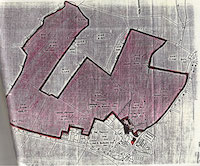
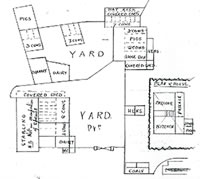
The northern part of the Croft was sold in 1986 and the rest of the land plus the farm buildings in 1988 for development. Springhill Farm itself remained with the Spence family until the death of Harry in 2007.
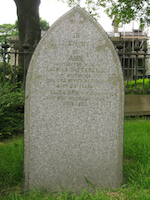
IN
MEMORY
OF
ANN
THE BELOVED WIFE OF
JAMES TATTERSALL
OF BOOTHFOLD
WHO DIED MARCH 27TH 1873
AGED 26 YEARS
AND OF ELIZA ANN THEIR DAUGHTER
WHO DIED MARCH 26TH 1873
AGED 1 DAY.
A baby dies virtually at birth and her mother the day after. Common causes of maternal mortality in C19 were puerperal sepsis and post partum haemorrhage but usually in those cases the baby survives. Eclampsia, involving high blood pressure, fits and kidney problems often caused the death of both mothers and babies so this was a possibility. Obstructed labour was a relatively uncommon cause of both maternal and infant mortality.
Speculation over, I ordered the birth certificates.
Eliza Ann Tattersall d 26th March 1873 aged 12 hours Atelectesis Pulmonium since birth.
Ann Tattersall d 27th March 1873 aged 26 years Morbus cordis, unknown, Partuition, Failure of heart's action. 36 hours.
So Eliza's death was relatively straightforward. She was born in poor condition, needed resuscitation at birth (which she probably didn't receive) and never established a regular pattern of breathing. 'Atelectesis pulmonium' means 'collapsed, non-inflated lungs'.
So far so clear but why was Eliza born in poor condition? Unfortunately her mother's death certificate doesn't really help us here. 'Morbus Cordis' of unknown cause…that could be secondary to severe infection. Alternatively primary heart failure secondary to pregnancy does occur, it is relatively uncommon but the prognosis in 1873 would have been very poor. So I will go with sepsis, but that is pretty much an educated guess.
Whatever happened that left a father who suddenly lost both his wife and child. Thomas Tattersall, licensed victualler, b ~ 1846 was the landlord of the Pack Horse Hotel, Boothfold. The couple had another daughter, Alice, b ~ 1870.
He left 'all of my property and effects to my mother'.
He was awarded the British and Victory medals so presumably didn’t serve overseas in 1915, although his battalion did.
In 1911 he is enumerated at Meadow Head Farm, Stone Mason, single, 4 sisters and 3 brothers at home. The CWGC records his being the 'son of James and Margaret Driver of Cross Farm, Cloughfold’.These two farms are virtually at opposite ends of the same field so the family may have moved down the hill. As a stone mason he may have worked in the stone dressing works on the hill above Cloughfold.
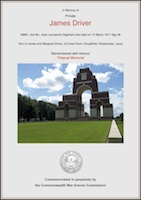
2 Btn East Lancashire was a regular battalion. They were in South Africa at the outbreak of WW1 but were stationed for pretty much the duration of the war on the Western Front. the returned from South Africa to Flanders in Nov 1914 and overwintered in the trenches.
Initially part of the 8th Division they transferred to 23rd Division on 18 Oct 1915 and returned to 8th Division 15 Jul 1916. They left the theatre in 1918, James Driver was dead by that time, presumably injured in the events surrounding Ancre in early 1917.
Address 1911 22 Dobbin Lane, cotton weaver, single, two older sisters at home.
Born Cloughfold
He left 'all I have to my mother'.
CWGC records 'son of Thomas and Mary Jane Dawson of Springhill Lodge'.
Soldiers Killed in Great War has ‘killed in action’, France and Flanders which doesn’t narrow it down much. His medal card shows that he received the victory medal, the British Medal and the 1915 star. It also states theatre of war ‘France’, and qualifying date of 14/8/15.
The regiment’s war diaries for 14/8/15 suggest that the main concern was that telephone communications were bad all day. The battalion had seen fierce fighting with the loss of some ground and life on 30 July and the entry for 12 August records that they will soon receive reinforcements, which duly arrived on 15/8 . Presumably Harry was one of these.
Approximately 180 men died from 8 Btn King’s Royal Rifles died in operations on 24 July 1816.
He was born in Rawtenstall as were his parents but his sister Ada, 6 years younger, was born in Accrington. Did they move out there and move back, or was his mother visiting?
in 1901 they were living in Ashworth St, Rawtenstall and in 1911 in 5 Nuttall Row, Dobbin Lane.
It doesn't help that of the three James Place in Rawtenstall in 1891, two were quarrymen and one a stone mason…
1918 and he is a private in the 2nd/7 Royal Warwickshire (325131). He transferred to them at an unknown time from the S Lancs Regiment (27620), for reason unknown. May 1918 finds him in the France/Flanders field where he died on May 15 and is buried IF 14 Robecq. The cemetery plan is available for download from the cwgc so we know where he lies…so sad. He was single.
An ordinary chap, another victim of an extraordinary war.
Sources:
1901 census RG 13/3850 p 28.
1911 census RG 14/24708
'Soldiers Died in the Great War' gives his place of birth and residence and regiment numbers.
His death notice in the Manchester Evening News (16 July 1917) says 'of Higher Cloughfold'. The ‘Soldiers Died in the Great War’ register has his death as ‘France and Flanders’ which narrows it down a bit…
He was the son of the late James and Maria Hart and on the 1911 census is enumerated at 199 Bacup Road Cloughfold, single, 1 brother and 1 sister at home. At that time he was a cotton spinner but later became the assistant librarian at Rawtenstall library. He was the librarian at Burnley Mechanics Institute on enrolment.
Harold's brother, John Hart, later owned Polefield Cottage. He left money to the Peace Pledge Union in his will. Was his pacifism influenced by his brother's death?
Commemorated A 46 Senquehart 1.
Address 1911 3 Lodge Fold, carter, married, no children.
CWGC 'husband of Mary Harvey, 5 Cherry Tree Cottages, Cloughfold'. In the census he is spouse of Margaret Jane.
Sadly he died in Oct 1918, just over a month before armistice.
He was awarded the British War and Victory Medals.
He was the son of Charles Harvey (Coal Dealer, of Cross Farm, Dobbin Lane) and his wife Ellen.
Thomas Harvey married Margaret Jane Brierley q4 1909 in Haslingden district.
It is possible that Margaret died in Prestwich asylum in 1913 age 24 and Thomas married Mary Wibden q2 1915. Mary was a spinster living in Merry Trees, Cloughfold in 1911.
Lodge Fold, where Thomas lived in 1911, was the farm and barn just south of Springhill. Sections dated from C17 and it it thought to have been the barn in which the dissenting congregation were granted a licence to worship in 1672.
The family are duly recorded in the same house in the 1901 census with the same children in the same order, except that there ‘Elizabeth Jane’ is down as ‘Margaret A’, age 2. Well the ‘age 2’ bit fits. There was a ‘Margaret Jane Bradshaw’ born q3 1899 in the Haslingden registration district (which covers our area) but she wouldn’t have been 2 at the time of the census and they obviously weren’t twins. Mmm, interesting. Elizabeth Jane at birth, Margaret A in 1901 and Elizabeth Jane in 1911? Really? Richard Bradshaw gave his occupation in 1901 as ‘coal miner’, and so may have worked for one of John Ashworth’s companies - he of Springhill House.
To return to the Great War.
Elizabeth enrolled with the QMAAC on 6/6/18 aged 20. At the time of enrolment she was living in Bacup. She was posted initially to Chadderton Camp, Royton, then 53 (YS) Bn South Wales Borderers 16/7/1918. In Oct 1918 she was moved to the dispersal Camp Shoreham-on-sea Oct 1918 then to Sommerton Camp, Eastbourne on 4/4/19. She was discharged 5/12/1919 on termination of engagement.
Her records are incompletely completed (a common feature in this study!) so we know that she was 4'11" and 100 lbs, but her hair and eye colour omitted. She was described as 'small very nice bright girl, seems suitable' by M E Quinlan on her application form. At the time of application she was a glove machinist, having been a slipper worker in the meantime.
The thing I found surprising is that she was assessed for service as a waitress. Now i appreciate that even in war one must maintain standards but was waitresses really Britain’s greatest need at that time?
The question ‘what do you know of the applicant’s qualifications as a waitress and how qualified are you to speak for her?’ is variously answered by her referees:
‘in no way’
‘make a good one’ and
‘I don’t know what sort of waitress she would make’
Further details are available in the transcripts of her service records.
He is shown as being ‘of Springhill’ in Kelly’s Directory of Lancashire 1909. Interesting, as in 1911 he was enumerated at 20 Spa Lane, Hinckley, with his wife Annie Meriam Jenkins and daughter Gwyneth Irene (b ~1901, Rhyndwyclydah, Glamorgan) and son Jenan Kenneth (b~ 1906 Hinckley, Leics). Another child was recorded as deceased.
Just to confuse things, Rev Jenkyn Thomas was minister at Rawtenstall Unitarian church between 1902-1906.
Kellys' Directory of Lancashire 1909 shows Jenkins, Rev Thomas Josef (Unitarian) at Springhill. The Unitarian History Society records:
'JENKINS, Thomas Josef, B 21 Nov 1871 near Lampeter, Car Min 1896-1918. from 1913 at Newchurch, d Newchurch D 14 March 1918 at Newchurch. I:1918, 91 *1919.'
Census:
1911 RG14 - PN19008 RD402 SD2 ED1 SN226
b 3q 1886 Haslingden registration district to Thomas and Alice Pilkington.
The family obviously liked to name their children after major military figures as he had a sibling named Lord Nelson Pilkington. Perhaps it was fitting that in 1891 the family lived at Napoleon's buildings, Cawl Terrace, Cloughfold where the enumerator helpfully records that Wellington and several of his siblings were born.
For the record, siblings are:
Joseph b ~ 1865
Nellie b ~ 1867
Jane b ~ 1868
James Edward b ~ 1870
Willie b ~ 1875
Robinson b ~ 1876
William Carr b ~ 1877 (not Willie, different place of birth)
(Thomas married Alice Lord, Haslingden, q3 1885)
(Wellington b 1887)
Lord Nelson b ~ 1887
Polly b ~1893
Alice b ~ 1894
Leonard b ~ 1899
He married Emily Blunt in q3 1906 and by 1911 was living in 17 Greenhill with his wife and children Margaret Alice (b~ 1907) and Thomas (b~1910). Wellington and Emily were both cotton weavers.
So WW1 came and Wellington enlisted in 9 Btn East Lancs, reg no. 14959 . He entered the theatre of war (1 - so Western Europe somewhere) on 5/9/15 (thus getting his 1915 star).
He was killed in action on 27 Dec 1916 in Salonika.
British Pathe footage of the Salonika campaign. I haven't checked these.
And a bizarre piece of product placement from the Burnley Express 27 March 1915:
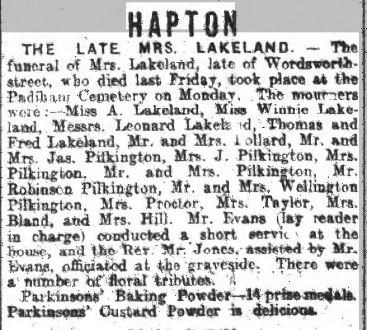
Sources:
birth GRO 8e 118
1881 census RG 11/4131 p 172-3
marriage Thomas - Alice 8e 202
1891 census RG 12/3351 p 14
marriage Wellington - Emily 8e 258
1901 census RG 13/3850 folio 79 p 27
His father Samuel also lived at Springhill House during his final illness. Samuel was alderman and JP for many years and Mayor of Rawtenstall who was given the freedom of the borough in 1919. He is commemorated by Compton’s cross, high above Clowbridge. The casket commemorates Samuel being given the freedom of the borough.
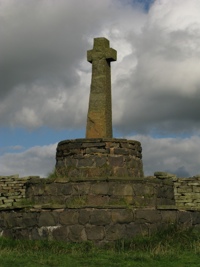
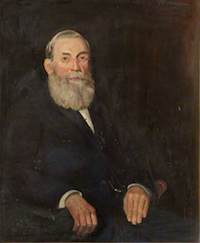
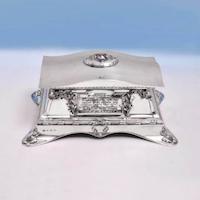
Compston’s cross Samuel Compston Freedom casket, Samuel
Edmund Leach Compston was born Settle, N Yorks, 3q 1870, the son of Samuel and Mary Ann Compston.
Samuel is listed on the 1881 census as ‘medical practitioner - unregistered’ living at Swinshaw, Higher Booths, Rossendale. As Swinshaw is at the top of the hill it seems a strange place to put a doctor. 1891 has Samuel as a ‘homeopathic practitioner (not registered)’. It is interesting that there was a demand for homeopathy in Rossendale at that time. EL is enumerated as a medical student at his parent’s address.
In 1901 and 1911 he is in Crawshawbooth with his family including daughters Flora (b ~ 1898) and Marjorie (b~1900). He had married Elizabeth Ellis q3 1984 in Prestwich. He was practising from his father’s house in 1901 with Samuel being enumerated as ‘Drs Pharmacist and dispenser’
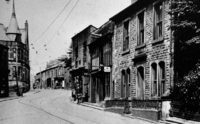 Lilac House, Crawshawbooth home of EL Compston on right.
Lilac House, Crawshawbooth home of EL Compston on right.EL Compston bought Springhill House in 1934 and set about converting it into a series of dwellings. Springhill house was subdivided into three - Compston’s portion retained the name Springhill House, with Lawn House and Sunset View being formed from the remainder. The Cot was formed from an outbuilding of what is now Sunset View and The Bungalow from the old billiard hall of Springhill House.
Apparently his embarkation details to New York include a description of a ‘cut on nose’ as an identifying feature.
details
1881 census:
Civil parish: Higher Booths Lancashire Street Address: Swinshaw Registration district: Haslingden Sub-registration district: Rossendale ED, 2 Piece: 4132
Folio: 54 Page Number: 43
1891 census:
Civil parish: Higher Booths Ecclesiastical parish: All Saints Town: Crawshaw Booth Lancashire Registration district: Haslingden Sub-registration district: Rossendale ED, 2 Piece: 3349 Folio: 49 Page Number: 40
1901 census:
Civil parish: Rawtenstall Ecclesiastical parish: Crawshaw Booth St John Lancashire Registration district: Haslingden Sub-registration district: Rawtenstall ED, 6 Household schedule number: 216 Piece: 3846 Folio: 133 Page Number: 33
1911 census:
Civil parish: Rawtenstall Lancashire Street Address: Crawshawbooth Rawtenstall Marital Status: Married Occupation: Physician And Surgeon Registration district: Haslingden Registration District Number: 471
Sub-registration district: Rawtenstall ED, institution, or vessel: 05 Piece: 24699
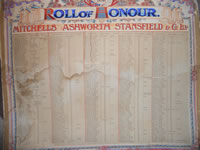
RJH married his cousin, the daughter of RJC's brother William Mitchell in 1910.
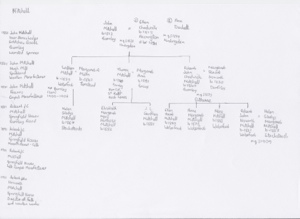
By 1911 RJH was living in Springhill House where he remained until 1923.
As an aside he was found to be keeping the highways in disrepair on some land he owned in Barley, north of Burnley in 1912. He paid for their immediate repair and the council adopted them thereafter.
Albert and Sarah married in Whittlesy, Cambridgeshire. From the 1911 census, Sarah was born in 1887 in Elsworth, Cambs but it seems she was actually born 1891 in Whittlsey, Cambs…not desperately close to Elsworth…in the wrong decade… If she is the correct one then she is daughter of John Eason, brick yard labourer and his wife Alice. In 1890 she was in Claygate, Whittlsey.
So how did Albert, born Bacup, come to marry Sarah, who appeared to live all her life in Cambridgeshire?
Albert Pope was the son of Alfred Pope who indeed was living in Bacup in 1891. Alfred was a stone mason and he and his wife Mary Elizabeth nee Cross were both born in Ely. They married in Haslingden district (the local one for Springhill and indeed for Bacup) in 1884. Prior to this they and their parental families seem to have been in Ely since c 1859 and Thelford before then.
I haven't established a connection between Sarah Eason and either the Pope or Cross families, so don't know if Albert married a cousin. Neither do I know precisely what led to Alfred the stone mason to travel from Cambridgeshire to Rossendale. 1890s was a period of mill building and the quarries were being expanded to provide the stone.
John Hart died in 1947, naming his wife Sarah Louisa (nee Murgatroyd) as sole Executrix, sole Trustee and main beneficiary. He willed that the properties be sold with the proceeds (apart from three personal bequests to various family members and friends) to be invested at Sarah Louisa’s absolute discretion with the income to be used for her own use absolutely.
She did not do this and continued to live in Polefield until her death in 1951. She also made a small number of personal bequests and willed that the remainder of her ‘property real and personal’ be treated as the residuary estate of her husband. Most of the Springhill houses had been sold off by that time so there may have been only Polefield and The Cottage left.
Her 3 executors were given £50 each for sorting this out.
As she made this will less that six months after her husband’s death, she obviously had no intention of carrying out his wishes.
John Hart willed that after the death of Sarah Louisa that there be a number of small bequests then the residue be divided equally between nineteen relatives and friends whom he helpfully listed together with (for the most part) addresses and relationships. One of the fixed bequests (of £50) was to the Peace Pledge Union, raising the possibility that he may have been a conscientious objector in WW1 - another avenue for study sometime. His brother, Harold Hart, died in WW1.
After her death, Polefield was sold to the Trustees of Sion Baptist Church for use as a manse.
Sarah Louisa Hart left a bequest to her sister-in-law Sarah Evelyn Murgatroyd. Or rather, she willed that Sarah Murgatroyd’s oak table be returned to her….
His first love was chemistry, which was compulsory to school certificate level. Eileen Taylor (a later Springhill resident) recalls being called into his office to receive otherwise excellent school cert results only to be greeted with ‘you have FAILED in chemistry’. He had a reputation for hard work, high standards and not suffering fools, but was described as ‘not a caning man’.
He used to wear his glasses perched on his forehead giving him an appearance of ‘a cobra about to pounce’. He is said to have habitually dressed in black coat, striped trousers and wing collar.
He lived in Lawn House in the early 1920s just after the subdivision of Springhill House and is understood to have continued to live there until 1934 after which Lawn House was subdivided to the current Lawn House and Sunset View. Their billiard room is now The Bungalow but then was used to entertain select boys from the school in table tennis.
He retired in 1948 and died in February 1958 having spent his retirement in Wimbledon.
In 2001 his daughter Barbara returned to visit Lawn House, her childhood home, and kindly sent some pictures of the house in the 1920s.
Edmund Haworth Holden b q1 1883 Bolton 8c 417 s of Robert Percy Pilkington Holden and Sarah Ann nee Haworth.
m Harriet Nora Ormrod q3 1911 Bolton 8c 0579
daughter Margaret Ormrod Holden bap 7 June 1916 Newchurch St Nicholas (Parish record via OPC)
daughter Barbara Haworth Holden bap 24 Dec 1920 Newchurch St Nicholas (Parish record via OPC)
d 1958 Wimlbledon
Born in Bacup to the late Frances and Jim, he sadly leaves daughters Jan and Andrea, sons-in-law Alex and Stuart, and grandchildren Jamie-Lee, Thomas and Jac. Jim had several jobs after leaving school, working at Nesta, then as a driving instructor before movie to his passion of becoming a professional snooker player.
He also worked as a commentator for the BBC, later becoming one of the directors of the WPBSA and also working for many years as a snooker coach at Butlin's Holiday Camps where he made many friends."
Rossendale Free Press Oct 9 2015, Obituary submitted by Jim's family.
He was 12 world highest ranked snooker player in the 1976-7
He was quarter finalist of the world championships in 1976 and UK championships in 1977
He commentated on the 1985 snooker world cup final between Steve Davis and Dennis Taylor
He had a number of health issues in later life, with five months in hospital in 2014.
Books include 'Higgins, Taylor and Me' in 1986 and 'Play to win snooker' in 1988.
In 1979 he was appointed minister of Sion Baptist Chapel where he stayed for six years before moving to Brockley Baptist Church, S London, in 1986. After a period of ministry there he worked for a while in a retreat centre on Lindisfarne.
His passion was to help people understand faith and the Bible better. He explored the option of lecturing in Bible college but decided instead to train as a secondary school teacher which he did at Lancaster University. He taught RE at St Wilfred’s, Blackburn, from 2000-2006. It is alleged he performed a version of the Troggs’ ‘Wild Thing’ at a school talent show. He certainly was an expert in 1960s-70s pop trivia and therefore a useful person on a Trivial Pursuits team.
As minister of Sion he oversaw the transformation of the ‘old’ C19 chapel from a poorly maintained building (the congregation meeting in the schoolroom) to a set of flats which have been in demand since. Stone from the old chapel was reused in the flats and the complex was named ‘Litchford House’ after a Robert Litchford who donated land and property to the church in 1705. This was in the face of opposition from a local history group who were vocal in wanting the old building retained but less willing to pay for its upkeep when it was not in use for worship - a common problem in heritage and one with no easy answer.
Sadly Andrew died on 23 December 2006 aged 50.




